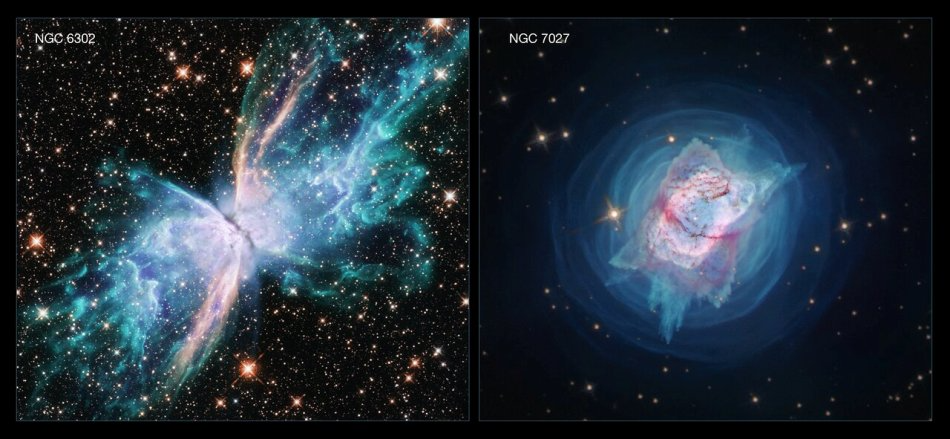Jun 19 2020
The NASA/ESA Hubble Space Telescope has captured the images of two new nearby young planetary nebulae, NGC 6302, also called the Butterfly Nebula, and NGC 7027, demonstrating its complete range of imaging capabilities.
 These two new images from the Hubble Space Telescope depict two nearby young planetary nebulae, NGC 6302, dubbed the Butterfly Nebula, and NGC 7027, which resembles a jewel bug. Both are among the dustiest planetary nebulae known and both contain unusually large masses of gas. Image Credit: NASA, ESA, and J. Kastner (RIT).
These two new images from the Hubble Space Telescope depict two nearby young planetary nebulae, NGC 6302, dubbed the Butterfly Nebula, and NGC 7027, which resembles a jewel bug. Both are among the dustiest planetary nebulae known and both contain unusually large masses of gas. Image Credit: NASA, ESA, and J. Kastner (RIT).
Both the planetary nebulae are among the dustiest known and contain remarkably large masses of gas, making them an intriguing pair for study by a group of researchers.
A majority of the stars are nuclear fusion engines that have calm lives for hundreds of millions to billions of years. However, when they reach the end of their lives, they tend to transform into wild whirligigs that blast off shells and jets of hot gas. Hubble has been used by astronomers to analyze such wild fireworks occurring in the two planetary nebulae.
The team has identified unmatched levels of rapid changes and complexity in the jets and gas bubbles that puff off the stars at the center of each nebula. Using Hubble, at present, the researchers are able to gain insights into the mechanisms behind this chaos.
Earlier, the Hubble Space Telescope has imaged such objects but not for so long and never with the help of the Wide Field Camera 3 instrument over its complete wavelength range—making observations in near-ultraviolet to near-infrared light.
These new multi-wavelength Hubble observations provide the most comprehensive view to date of both of these spectacular nebulae. As I was downloading the resulting images, I felt like a kid in a candy store.
Joel Kastner, Study Leader, Rochester Institute of Technology
The new images captured by Hubble show explicitly how both nebulae split themselves apart on very short timescales, allowing astronomers to observe the changes over the last 20 years. Specifically, the wider multi-wavelength views of each nebula allowed by Hubble have been useful for the researchers to trace the histories of shock waves in them.
Shocks such as those are usually produced when fresh, fast stellar winds crash into and wipe out more gradually expanding gas and dust discharged by the star in its recent past, producing bubble-like cavities with well-defined walls.
Astronomers consider that there two stars at the heart of each nebula orbiting around each other. The bizarre shapes of these nebulae are evidence for the existence of such a central “dynamic duo.” Each nebula includes a dusty, pinched waist and polar lobes, or outflows, together with other, highly complex symmetrical patterns.
According to prominent theory, such structures are formed in planetary nebulae as the mass-losing star is one of two stars in a binary system. Both the stars orbit each other sufficiently close that they ultimately interact, thereby generating a gas disk around one or both stars. Eventually, the disk launches jets that expand polar-directed lobes of outflowing gas.
As stated by another, related, popular theory, the smaller star among the pair could merge with its expanded, more quickly evolving stellar companion. Moreover, a very short-lived “common envelope” binary star configuration such as this can produce wobbling jets, which form the signature bipolar outflows generally observed in planetary nebulae.
However, the astronomers have not been able to observe the suspect companion stars in such planetary nebulae. Researchers suggest this may be because these companions are next to, or have already been swallowed by, far larger and brighter red giant stars.
NGC 6302, generally called the Butterfly Nebula, features a unique S-shaped pattern observed in reddish-orange in the image. Consider a lawn sprinkler that spins wildly and spews out two S-shaped streams. Here, it is not water in the air. Instead, it is gas blown out by a star at high speed.
Moreover, the “S” shape appears only when imaged by the Hubble camera filter that captures near-infrared emission from singly ionized iron atoms. This iron emission suggests the existence of energetic collisions between both fast and slow winds, which can be observed more commonly in active galactic nuclei and remnants of supernovae.
This is very rarely seen in planetary nebulae. Importantly, the iron emission image shows that fast, off-axis winds penetrate far into the nebula like tsunamis, obliterating former clumps in their paths and leaving only long tails of debris.
Bruce Balick, Study Team Member, University of Washington
The associated image of NGC 7027, which looks like a jewel bug, suggests that it gradually puffed away its mass in silent, spherically symmetric or even spiral patterns over several centuries—until relatively recently.
Something recently went haywire at the very centre, producing a new cloverleaf pattern, with bullets of material shooting out in specific directions.
Joel Kastner, Study Leader, Rochester Institute of Technology
Journal Reference:
Kastner, J. H., et al. (2020) First Results from a Panchromatic HST/WFC3 Imaging Study of the Young, Rapidly Evolving Planetary Nebulae NGC 7027 and NGC 6302. Galaxies. doi.org/10.3390/galaxies8020049.